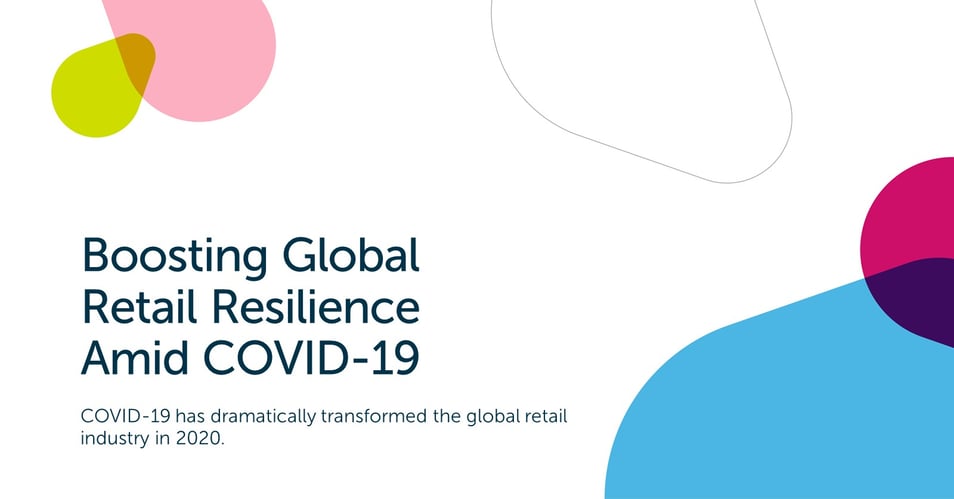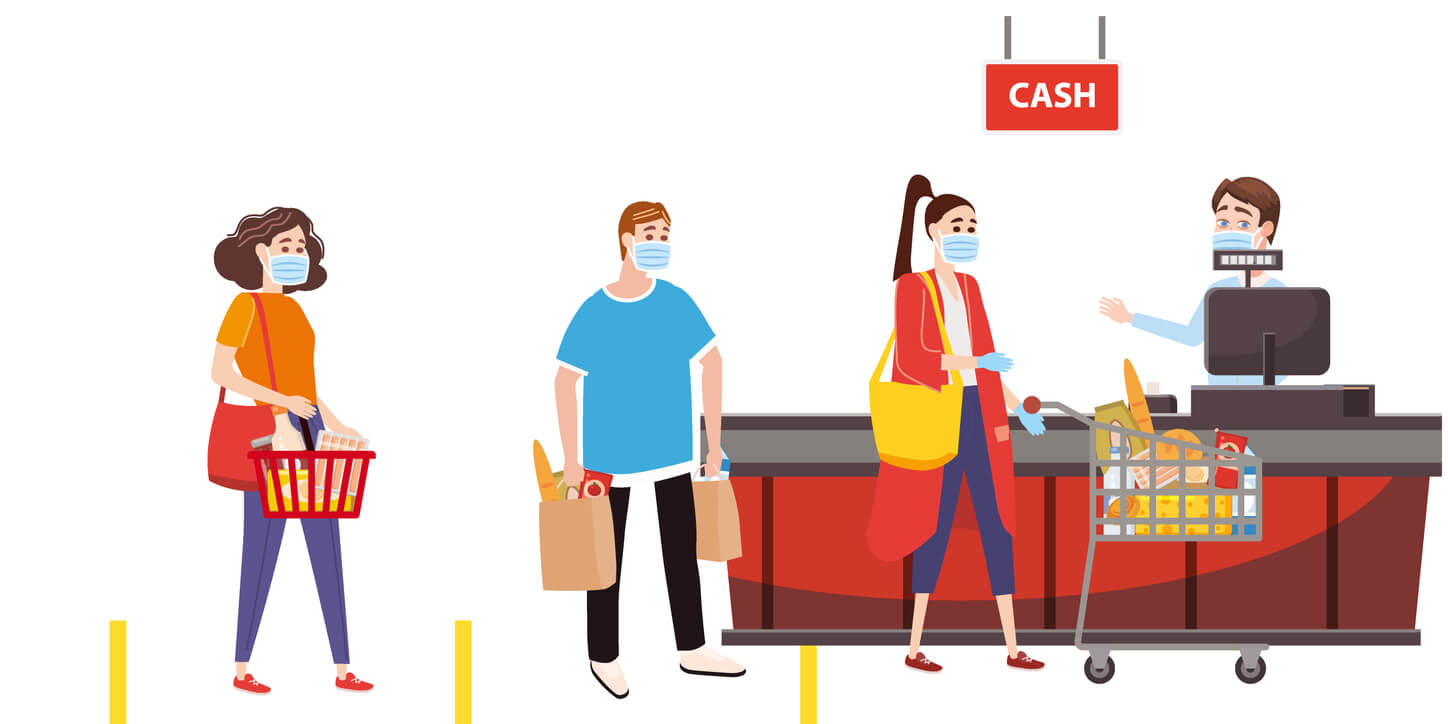
Boosting Global Retail Resilience Amid COVID-19
|
Private label
|
Food industry
Posted By:
Trace One
In April alone, U.S. retail sales plunged 16.4%(i). In Europe, experts say retailers lost $4.15 billion US during the six weeks ended April 21 due to disruptions caused by the coronavirus outbreak; they estimate Germany lost $926 million USD during that period(ii).
Yet, with more than one billion consumers homebound, restaurant and store closures, the global retail industry has proven essential and it faces a monumental opportunity to restore consumer confidence by adapting to new consumption trends.
For instance, grocery retailers and consumer packaged goods (CPG) manufacturers have benefitted from a surge in home cooking. Food and beverage sales rose 33% between December 2019 and March 2020. Between $61 billion and $118 billion in US food sales shifted from restaurants to grocery stores, equating to sales lifts of up to 62% in the quarter and 15% for the fiscal year(iii). Now 35% of food expenditures—more than $2.5 trillion globally—is up for grabs as consumers dine at home, shop online and discover new products(iv).
COVID-19 shakes up shopping habits
The coronavirus crisis has radically changed consumer behavior. By late February, consumers started to take the threat of COVID-19 seriously. During the initial pandemic frenzy, nervous consumers stocked up on grocery, pharmacy and personal care products, leading to distribution issues and lost sales due to product shortages(v). Early in the pandemic, demand for products like hand sanitizer, toilet paper, yeast and flour fluctuated dramatically, which strained the retail supply chain.

To protect their health and safety, consumers around the world are staying home more and shopping less frequently. As a result, their basket size per transaction has grown, as the average number of basket items increased by 65% during lockdown(vi).
The average number of basket items increased by 65% during lockdown
Key consumer trends during the pandemic include:
E-commerce: A global study found one-third of households increased their online spending during lockdown and one-third also said their online shopping would increase in the future(viii). A US study found first-time users accounted for 41% of online grocery shoppers using e-commerce during the pandemic(ix).
Price-conscious shoppers: Between April and May, the percentage of consumers who say they will pay more attention to prices rose from 59% to 68%. Discretionary spending will fall, as more consumers deliberately save money due to job losses and tighter budgets, given the ambiguous duration of the pandemic(x).
Buy local: Around the world, more consumers now prefer products produced locally. Two-thirds of respondents in a 2020 survey said they prefer to purchase goods from their own country, especially among consumers in China, Italy, South Korea and Spain(xi). Accenture cites growing demand for locally-sourced and artisanal products, and a desire to support stores in local communities(xii).
Global retail responses to COVID-19
Retailers have demonstrated diverse ways to adapt their processes to the pandemic. Their methods include curbside pickup at Aldi, micro-fulfillment centers at Kroger, 3D imaging for crowd counting at Tesco, strict sanitization protocols at Carrefour, cashless payment at Mercadona and even the use of in-store robots to encourage social distancing at Edeka(xiii).
Meanwhile, more CPG manufacturers are investing in direct-to-consumer (DTC) strategies to deliver products straight to consumers. US DTC online sales could grow more than 24% this year, fuelled by the pandemic. Yet cash flow problems persist. Only essential retailers in grocery and pharmacy were allowed to remain open throughout the entire pandemic(xiv).
Other retailers had to shutter their stores and forego revenue. As a result, retailers across channels have reached out to their suppliers, canceling shipments and asking for longer payment terms(xv).
In early March, nearly 75% of companies reported supply chain disruptions due to coronavirus-related transportation restrictions, including production delays, longer lead times, lack of supplier visibility and sourcing issues(xvi).

Today supply chain disruption continues to impact global retail due to changes in consumer demand, materials and delivery. Siloed, fragmented and manual communication processes prevented the prompt sharing of vital information across global teams and supply chains.
"To come out as winners, grocery retailers need to make bold moves now.”
~ Boston Consulting Group
For instance, despite the surge in online orders, out-of-stock issues still plague the retail supply chain. As of June 3, Euromonitor International reports the out-of-stock rates for essential SKUs in the online channel were:
-
22% in Canada
-
16% in Ireland
-
12% in Spain
-
11% in the US
-
10% in the UK
-
10% in France
-
10% in the Netherlands
-
9% in Germany
-
9% in Italy
-
7% in Switzerland
McKinsey reports e-commerce transactions in Italy rose by 81% from February to the end of April as more consumers relied upon online shopping for their needs during the lockdown(xviii). Yet Italy suffered retail sales declines of up to 40% and stores that reopened faced huge stockpiles of unsold inventory and no tourism to support sales(xix).
2020 global retail trends
To adapt to COVID-19’s impact on business and consumer behavior, more global retailers and manufacturers are adapting to these trends:
Digitization: To accelerate through retail’s recovery period and protect the supply chain, Bain & Company recommends that companies proactively use digitalization with supply chain partners to increase operational resilience, scale and speed(xx). Retail companies that were agile during lockdown were most successful in adapting to new consumer trends, whereas experts warn that retailers or manufacturers that were slow to respond to the online shift will be left behind(xxi).
Collaboration: Now, more than ever, collaboration among retailers and manufacturers is crucial to deliver products faster to respond to consumers’ needs.19 Bain found a 48% increase in companies spending on collaboration tools as a direct result of COVID-19, as “collaboration tools can often be more efficient than jumping on a plane(xvii xviii).” Closer collaboration helps supply chains share information to align teams and improve retail processes. By working together, retailers and manufacturers can help consumers feel more confident in the reliability of the supply chain.
‘Buy local’: To adapt to consumer demand for domestic production, retailers can work with local CPG manufacturers, celebrate local goods and sourcing, customize their assortments for local needs and engage in locally-relevant marketing(xxiv). Also, manufacturers can source more raw materials and packaging partners within their domestic market(xxv).
Private label: With consumers increasingly concerned about risks to their own health and finances, retailers can gain market share through differentiated private label lines that reflect consumer desire for value, nutrition and health(xxvi). Private labels also give retailers more control over their assortment, including providing value for both the budget-sensitive and the less price-conscious shopper(xxvii).
Purpose: During the pandemic, more retailers pivoted to serve a higher purpose. In the UK, IKEA transformed a parking lot into a testing facility for healthcare workers. Spanish apparel giant Inditex, which owns Zara, has switched production to manufacture hospital gowns. French luxury icon LVMH manufactured hand sanitizer for European hospitals for free and purchased ventilators to be delivered to French hospitals(xxviii). Altruistic acts resonate with consumers by putting people ahead of profit.
Looking forward, together
As global retail recovers from the profound changes created by COVID-19, these 2020 trends guide retailers and manufacturers as they plan a way forward. Adapting to these consumer trends and market factors can help companies gain efficiency, agility and unity in their approach. A collaborative mindset can help supply chains promptly adapt to shifts in consumer buying habits and improve supply chain effectiveness.
In these challenging times, Trace One supports global retailers and brands by helping them work together as collaborative partners. Trace One solutions make it easier for retail companies to adapt to COVID-19’s effects. For instance, retailers can quickly find new reliable suppliers to overcome supply chain issues and communicate effectively with suppliers for greater resilience and agility. In addition, suppliers can find new customers through easy, online product discovery. Both retailers and suppliers can collaborate more efficiently to speed up time to market for a superior customer experience that restores consumer trust and deepens their loyalty.
i) Reinicke, Carmen. US retail sales plunged an unprecedented 16.4% in April, roughly double the prior record. Business Insider. May 15, 2020.
ii) Sabanoglu, Tugba. Coronavirus in Europe: impact of lost sales for retailers March-April 2020. Statista. May 27, 2020.
iii) Springer, Jon. Coronavirus Sales Boom Could Be Short-Lived and Costly, Analyst Warns. Winsight Grocery Business. March 16, 2020.
iv) Biggs, Chris, Khaled Tawfik , Ameya Avasare, Henry Fovargue, Dewang Shavdia, and Gavin Parker. The $2.5 Trillion Opportunity for Grocers That Are First to the Future. Boston Consulting Group. May 19, 2020.
v) Viswanathan, Venkat. Will This Crisis Change The World Of Grocery Shopping Forever? Forbes. June 3, 2020.
vi) Advancing in the Next Normal: How the FMCG industry can prepare for lasting changes. IRI. May 2020.
vii) Advancing in the Next Normal: How the FMCG industry can prepare for lasting changes. IRI. May 2020.
viii) Yining, Ding. Retail rules rewritten as consumer trends change. Shine. June 3, 2020.
ix) Biggs, Chris, Khaled Tawfik , Ameya Avasare, Henry Fovargue, Dewang Shavdia, and Gavin Parker. The $2.5 Trillion Opportunity for Grocers That Are First to the Future. Boston Consulting Group. May 19, 2020.
x) Yining, Ding. Retail rules rewritten as consumer trends change. Shine. June 3, 2020.
xi) Yining, Ding. Retail rules rewritten as consumer trends change. Shine. June 3, 2020.
xii) COVID-19 will permanently change consumer behavior. Accenture. April 28, 2020.
xiii) Edeka deploys Pepper robot to combat coronavirus. Retail Technology Innovation Hub. April 7, 2020.
xiv) Rueter, Thad. Pepsi Launches DTC Sites for Pandemic Shoppers. Progressive Grocer. May 11, 2020.
xv) Unglesbee, Ben. Suppliers are feeling retail's pain, too. Retail Dive. April 29, 2020.
xvi) COVID-19 Survey: Impacts On Global Supply Chains. Business Facilities. March 12, 2020.
xvii) Biggs, Chris, Khaled Tawfik , Ameya Avasare, Henry Fovargue, Dewang Shavdia, and Gavin Parker. The $2.5 Trillion Opportunity for Grocers That Are First to the Future. Boston Consulting Group. May 19, 2020.
xviii)Sneader, Kevin and Shubham Singhal. The future is not what it used to be: Thoughts on the shape of the next normal. McKinsey & Company. April 14, 2020.
xix) Global green shoots: How retail around the world is beginning to re-emerge. ModernRetail. June 1, 2020.
xx) Saenz, Hernan and Dunigan O'Keeffe. Covid-19: Protect, Recover and Retool. Bain & Company. April 10, 2020.
xxi) Unglesbee, Ben. Suppliers are feeling retail's pain, too. Retail Dive. April 29, 2020.
xxii) Heap, Simon, Greg Fiore, David Crawford and Anne Hoecker. Lockdowns Spike Spending on Collaboration and Software Tools. Bain & Company. June 3, 2020.
xxiii) De Vusser, Christophe. How European Private Equity is Taking Coronavirus’ First Punch. Bain & Company. June 3, 2020.
xxiv) COVID-19 will permanently change consumer behavior. Accenture. April 28, 2020.
xxv) Advancing in the Next Normal: How the FMCG industry can prepare for lasting changes. IRI. May 2020.
xxvi) Biggs, Chris, Khaled Tawfik , Ameya Avasare, Henry Fovargue, Dewang Shavdia, and Gavin Parker. The $2.5 Trillion Opportunity for Grocers That Are First to the Future. Boston Consulting Group. May 19, 2020.
xxvii) Advancing in the Next Normal: How the FMCG industry can prepare for lasting changes. IRI. May 2020.
xxviii) Robles, Maria Coronado. The Rise of “Purpose-Driven” Businesses During COVID-19. Euromonitor International. June, 2020.